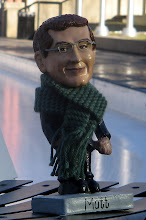 I recently watched Touch the Sound, a documentary exploring the life and art of percussionist Evelyn Glennie. For all her extraordinary abilities - her courage, sensitivity, charisma, focus, compassion - it seems rather petty to emphasize her one 'disability.' And in fact the film takes a long while to even mention that Glennie is deaf. For the first half hour or so, we follow Glennie around on several musical projects, from an improvised recording session in an abandoned warehouse with Fred Frith, to a jam session with Taiko drummers in Tokyo, to an impromptu snare drum solo in New York's Grand Central Station.
I recently watched Touch the Sound, a documentary exploring the life and art of percussionist Evelyn Glennie. For all her extraordinary abilities - her courage, sensitivity, charisma, focus, compassion - it seems rather petty to emphasize her one 'disability.' And in fact the film takes a long while to even mention that Glennie is deaf. For the first half hour or so, we follow Glennie around on several musical projects, from an improvised recording session in an abandoned warehouse with Fred Frith, to a jam session with Taiko drummers in Tokyo, to an impromptu snare drum solo in New York's Grand Central Station.I began to wonder if all I had heard about her deafness wasn't exaggerated or invented - far from handicapped, she seemed one of the most fully alive and functional people I've ever watched. Eventually the film explains how she began studying music as a young girl, trying out several different instruments under the guidance of her father, a rather free-thinking accordion player. She had settled on percussion just as her hearing loss began to grow serious, and she was told by hearing experts that she would no longer be able to play. She described the strange finality of that diagnosis - having been fully, joyfully engaged in music just half an hour before, now with just a few words this doctor had apparently made that act impossible.
Fortunately Glennie and her family didn't accept the diagnosis; and while her audiology tests only worsened, she was learning to "hear" with her hands, and then to use her whole body as a resonating chamber for sound. She developed an astonishing degree of sensitivity to subtle nuances of vibration - learning to distinguish the smallest intervals of pitch and actually hearing more fully and deeply, by means of touch, than any so-called hearing person could with her ears.
It seems strange to envy a deaf person her hearing abilities - but the more I watched Evelyn Glennie, exploring the vibratory possibilities of every surface, object, and even people she encountered, the more I wished I could just shut my ears and listen through touch. The irony is that we all can listen in that way, and we do in fact - but just less consciously, and without the sensitivity and subtlety that Glennie has developed. When I sit down with my bass, I realize there are an enormous variety of vibrations passing through me; an E-flat might ripple up my left thight, while a B-natural harmonizes with my stomach, and a martele stroke on the D-string massages the tops of my feet. And even the floor resonates noticeably, sending vibrations up my legs and through the stool I sit on.
There is more than enough to occupy the mind, just keeping track of all those resonant sensations. Which is perhaps the difficulty, since when overwhelmed the mind falls back on the simplest, most direct signal - the ears. And so we lose the input of the rest of our senses, and the many dimensions of a full sound experience. Thinking of Evelyn Glennie's story, at least I can remember that fuller experience does exist, and can look for the kinesthetic awareness and mental space to listen in to it.
Touch the Sound is truly a delightful celebration of all the senses - entrancing sounds combine with beautiful images, like the long streams of ticker-tape unspooling in the empty warehouse, and all the while you're tempted to clink a cup, rub the rim of a glass, even to feel the rumble of your subwoofers and just get up and dance. It's a very inspiring journey - though if you should choose to improvise an extended solo on the back of a family member's head, you might be best off using your softer mallets.


 Technorati Link Count: no. of blog reactions to this post
Technorati Link Count: no. of blog reactions to this post
1 comment:
It's amazing. But it is true, we can actually touch the sound. :)
I love the vibrations from the double bass. It rocks and recharges!
Post a Comment